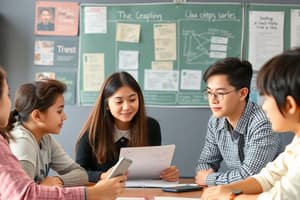Podcast
Questions and Answers
Which of the following is more important for effective second-language acquisition?
Which of the following is more important for effective second-language acquisition?
- Memorizing and practicing frequently used words or phrases
- Interacting primarily with the teacher and other adults
- Engaging in social activities and meaningful interactions (correct)
- Learning with various structured and rote activities
Which of the following statements is primarily true about the relationship between a student's first- and second-language acquisition?
Which of the following statements is primarily true about the relationship between a student's first- and second-language acquisition?
- Students who receive formal schooling in L1 do worse at acquiring L2 than students with no schooling in L1
- Cognitive development in L1 should be discontinued through the elementary years in order to achieve cognitive and academic success in L2
- Students who receive formal schooling in L1 do better at acquiring L2 than students with no schooling in L1 (correct)
- Cognitive development in L1 should be limited through the elementary years in order to achieve cognitive and academic success in L2
It is most important for a teacher who provides content instruction to ESL students to do which of the following?
It is most important for a teacher who provides content instruction to ESL students to do which of the following?
- Expect the ESL students to remain academically behind their peers
- Discourage ESL students from using nonstandard English
- Provide lower-level content instructional materials to the ESL students
- Incorporate content materials that are culturally relevant (correct)
Hanh, a Vietnamese student, has been in the United States for 18 months. She is progressing in her schoolwork but she rarely speaks to her classmates or teachers. Which of the following is the best action for the teacher to take to help increase Hanh's oral proficiency in English?
Hanh, a Vietnamese student, has been in the United States for 18 months. She is progressing in her schoolwork but she rarely speaks to her classmates or teachers. Which of the following is the best action for the teacher to take to help increase Hanh's oral proficiency in English?
Which of the following statements is most accurate regarding the transfer of literacy knowledge and skills from L1 to L2?
Which of the following statements is most accurate regarding the transfer of literacy knowledge and skills from L1 to L2?
Which of the following is the best strategy to help ELLs when having phonetic struggles?
Which of the following is the best strategy to help ELLs when having phonetic struggles?
An ESL teacher wants to use graphic organizers to help ELLs understand expository texts. Which four of the following graphic organizers are best to use for this purpose?
An ESL teacher wants to use graphic organizers to help ELLs understand expository texts. Which four of the following graphic organizers are best to use for this purpose?
An ESL teacher finds it difficult to set aside time to observe the specific academic language proficiency of the ELLs in the classroom. Therefore, the teacher makes notes on ELL's progress as it is observed during the natural course of the school day. The teacher is primarily using:
An ESL teacher finds it difficult to set aside time to observe the specific academic language proficiency of the ELLs in the classroom. Therefore, the teacher makes notes on ELL's progress as it is observed during the natural course of the school day. The teacher is primarily using:
What is the best strategy for helping Martin remember the meaning of an idiom he encounters?
What is the best strategy for helping Martin remember the meaning of an idiom he encounters?
Flashcards are hidden until you start studying
Study Notes
Effective Second-Language Acquisition
- Social activities and meaningful interactions are crucial for effective second-language acquisition.
- Memorization and frequent practice of phrases are less effective than engaging in real-life communication.
First- and Second-Language Acquisition Relationship
- Formal schooling in the first language (L1) enhances second language (L2) acquisition.
- Students with no schooling in L1 may struggle more with L2.
Content Instruction for ESL Students
- Content materials must be culturally relevant to engage ESL students effectively.
- Teachers should not expect ESL students to be academically behind or discourage the use of nonstandard English.
Increasing Oral Proficiency in ESL Students
- Role-playing and daily lessons on social interactions are effective for improving oral proficiency.
- Partnering with English-speaking peers can facilitate practice but may not be as effective as integrated lessons.
Literacy Transfer from L1 to L2
- Positive transfer of literacy skills occurs when L1 experiences include native language scaffolding.
- Confined literacy instruction to L1 or L2 can hinder overall literacy development.
Phonetic Struggles in ELLs
- Small group lessons focusing on phonetics, such as digraphs and vowel sounds, are beneficial.
- Providing context clues during reading is important but may not address phonetic issues directly.
Graphic Organizers for Expository Texts
- Effective graphic organizers include Venn Diagrams, Timelines, Thinking Maps, and Word Webs.
- These tools help ELLs structure information and enhance comprehension of complex texts.
Observing Academic Language Proficiency
- An anecdotal log allows teachers to track ELL progress informally during daily interactions.
- This method provides insights into students' academic language use without formal assessments.
Understanding Idioms in Reading
- After explaining an idiom, visual representation (like drawing) helps reinforce understanding.
- Translation or dictionary definitions may not aid in the retention of idiomatic expressions.
Studying That Suits You
Use AI to generate personalized quizzes and flashcards to suit your learning preferences.





